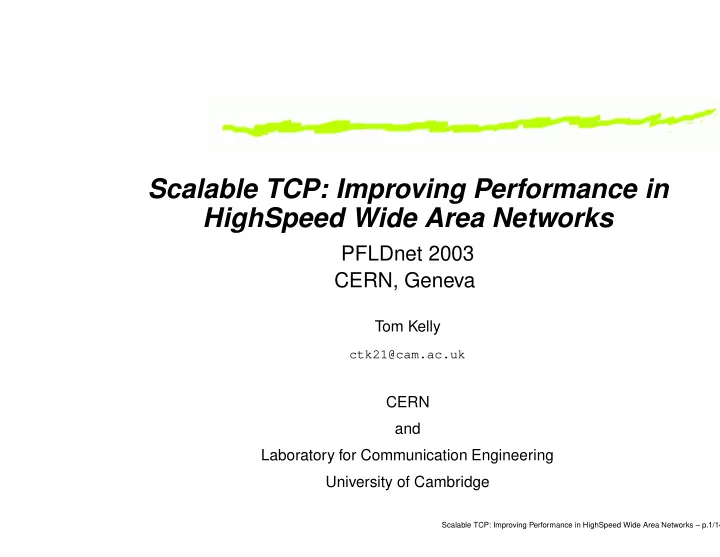

Scalable TCP: Improving Performance in HighSpeed Wide Area Networks PFLDnet 2003 CERN, Geneva Tom Kelly ctk21@cam.ac.uk CERN and Laboratory for Communication Engineering University of Cambridge Scalable TCP: Improving Performance in HighSpeed Wide Area Networks – p.1/14
Motivation Poor performance of TCP in high bandwidth wide area networks due to TCP congestion control algorithm for each ack in a RTT without loss: 1 cwnd r �→ cwnd r + cwnd for each window experiencing loss: cwnd r �→ cwnd r − 1 2 cwnd r Throughput Window Loss recovery time Supporting loss rate 5 . 4 × 10 − 5 10Mbps 170pkts 17s 5 . 4 × 10 − 7 100Mbps 1700pkts 2mins 50s 5 . 4 × 10 − 9 1Gbps 17000pkts 28mins 5 . 4 × 10 − 11 10Gbps 170000pkts 4hrs 43mins Characteristics of a 200ms, 1500 MTU TCP connection Scalable TCP: Improving Performance in HighSpeed Wide Area Networks – p.2/14
Changing congestion control - aims and assumptions Make effective use of high bandwidth links Changes need to be robust in a wide variety of networks and traffic conditions L2 switches, bugs, packet corruption, reordering and jitter Do not adversely damage existing network traffic Do not require manual tuning to achieve reasonable performance 80% of maximal performance for 95% of the people is fine Scalable TCP: Improving Performance in HighSpeed Wide Area Networks – p.3/14
The generalised Scalable TCP algorithm Let a and b be constants and cwnd be the congestion window for each ack in a RTT without loss: cwnd �→ cwnd + a for each window experiencing loss: cwnd �→ cwnd − b × cwnd Loss recovery times for RTT 200ms and MTU 1500bytes Scalable TCP: log (1 − b ) log (1+ a ) RTTs e.g. if a = 0 . 01 , b = 0 . 125 then it is about 2.7s Traditional: at 50Mbps about 1min 38s, at 500Mbps about 27min 47s! Scalable TCP: Improving Performance in HighSpeed Wide Area Networks – p.4/14
The Scalable TCP algorithm Rate Rate c −log(1−b) 2 (pkts/RTT) (pkts/RTT) log(1+a) c c bc c 2 (1−b)c c 2 Time (RTT) Time (RTT) Rate Rate C −log(1−b) 2 (pkts/RTT) (pkts/RTT) log(1+a) C C bC C (1−b)C 2 C 2 Time (RTT) Time (RTT) Scalable TCP: Improving Performance in HighSpeed Wide Area Networks – p.5/14
Fairness Choose a legacy window size, lwnd When cwnd > lwnd use the Scalable TCP algorithm When cwnd ≤ lwnd use traditional TCP algorithm Standard TCP 1000 Scalable TCP Window size (pkts) 100 10 1 0.0001 0.001 0.01 0.1 Loss rate Same argument used in the HighSpeed TCP proposal Fixing lwnd , fixes the ratio a b Scalable TCP: Improving Performance in HighSpeed Wide Area Networks – p.6/14
Control Theoretic Stability Theorem (Vinnicombe): The generalised Scalable TCP algorithm is locally stable about equilibrium, if p j (ˆ y j ) a < ∀ j ∈ J ˆ j (ˆ y j ) y j p ′ where ˆ y j is the equilibrium rate at each link, p j ( y ) is the probability of loss at link j for an arrival rate y , and J is the set of all links With appropriate buffer sizes or AQM stability can be ensured Scalable TCP: Improving Performance in HighSpeed Wide Area Networks – p.7/14
Variance and Convergence b a Rate CoV Loss recovery Rate halving Rate doubling time time time 1 2 0.50 17 . 7 T r (3.54s) T r (0.20s) 17 . 7 T r (3.54s) 2 50 1 1 0.35 14 . 5 T r (2.91s) 2 . 41 T r (0.48s) 35 T r (7.00s) 4 50 1 1 0.25 13 . 4 T r (2.68s) 5 . 19 T r (1.04s) 69 . 7 T r (13.9s) 8 100 1 1 0.18 12 . 9 T r (2.59s) 10 . 7 T r (2.15s) 139 T r (27.8s) 16 200 Scalable TCP: Improving Performance in HighSpeed Wide Area Networks – p.8/14
Parameter choice and Implementation lwnd = 16 , a = 0 . 01 , andb = 0 . 125 represents a good trade off of concerns Patch against Linux 2.4.19 implements Scalable TCP algorithm Linux already implements reordering detection, SACK, and rate halving Some driver details (bugs?) fixed for Gbps operations Scalable TCP: Improving Performance in HighSpeed Wide Area Networks – p.9/14
Bulk throughput DataTAG 2.4Gbps link and minimal buffers (2048/40) Flows transfer 2 gigabytes and start again for 1200s Number 2.4.19 2.4.19 TCP & giga- Scalable of flows TCP bit device buffer TCP 1 7 16 44 2 14 39 93 4 27 60 135 8 47 86 140 16 66 106 142 Scalable TCP: Improving Performance in HighSpeed Wide Area Networks – p.10/14
Web traffic results DataTAG 2.4Gbps link and minimal buffers (2048/40) 4 bulk concurrent flows across 2 machines for 1200s 4200 concurrent web users across 3 machines Type of bulk transfer Web traffic trans- 2 Gigabyte trans users ferred fers completed No bulk transfers 65GB n/a TCP in 2.4.19 65GB 36 TCP in 2.4.19 & giga- 65GB 58 bit device buffers Scalable TCP 65GB 96 Scalable TCP: Improving Performance in HighSpeed Wide Area Networks – p.11/14
Conclusion Strong theoretical framework behind the algorithm Offers an easy evolution from the traditional TCP AMID scheme Freely available working code http://www-lce.eng.cam.ac.uk/˜ctk21/scalabl Scalable TCP: Improving Performance in HighSpeed Wide Area Networks – p.12/14
Where from here Correcting RTT bias in throughput allocation; methods similar to the parameter scaling used in previous ECN work Better code efficiency to improve robustness and performance of implementation AQM and ECN evolutions that can give extra performance in some scenarios Scalable TCP: Improving Performance in HighSpeed Wide Area Networks – p.13/14
More at http://www-lce.eng.cam.ac.uk/˜ctk21/scalable Scalable TCP: Improving Performance in HighSpeed Wide Area Networks – p.14/14
Recommend
More recommend